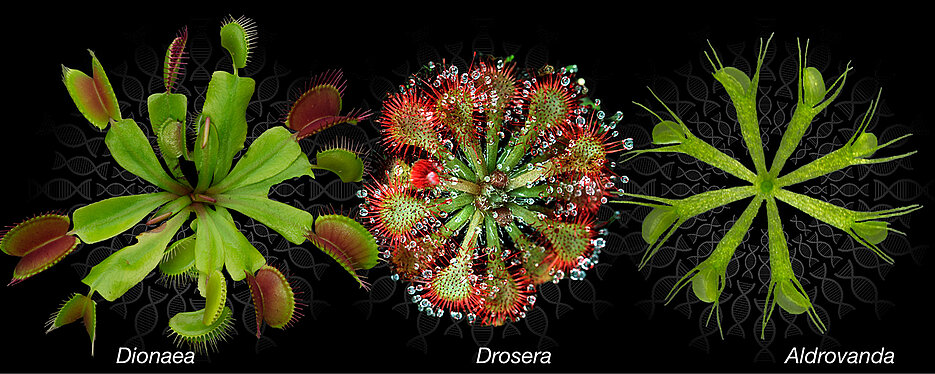The genomes of three carnivorous plants – the Venus flytrap, spoon-leaved sundew and the waterwheel plant – have been decoded. The result has caused some surprises.

Plants can produce energy-rich biomass with the help of light, water and carbon dioxide. This is why they are at the beginning of the food chains. But the carnivorous plants have turned the tables and hunt animals. Insects are their main food source.
A publication in the journal Current Biology now sheds light on the secret life of the green carnivores. The plant scientist Rainer Hedrich and the evolutionary bioinformatician Jörg Schultz, both from Julius-Maximilians-Universität (JMU) Würzburg in Bavaria, Germany, and their colleague Mitsujasu Hasebe from the University of Okazaki (Japan) have deciphered and analysed the genomes of three carnivorous plant species.
They studied the Venus flytrap Dionaea muscipula, which originates from North America, the globally occurring waterwheel plant Aldrovanda vesiculosa and the spoon-leaved sundew Drosera spatulata, which is widely distributed in Asia.
All three belong to the sundew family. Nevertheless, they have each conquered different habitats and developed their own trapping mechanisms. In Dionaea and Aldrovanda, the ends of the leaves are transformed into folding traps. The sundew, on the other hand, attaches its prey to the leaf surface with sticky tentacles.
Basic genes for carnivory
The first thing the international research team found out was that, despite their different lifestyles and trapping mechanisms, Venus flytrap, sundew and waterwheel have a common “basic set” of genes that are essential for the carnivorous lifestyle.
“The function of these genes is related to the ability to sense and digest prey animals and to utilise their nutrients,” explains Rainer Hedrich.
“We were able to trace the origin of the carnivory genes back to a duplication event that occurred many millions of years ago in the genome of the last common ancestor of the three carnivorous species,” says Jörg Schultz. The duplication of the entire genome has provided evolution with an ideal playing ground for developing new functions.
Genetic poverty despite a special way of life
To their surprise, the researchers discovered that the plants do not need a particularly large number of genes for carnivory. Instead, the three species studied are actually among the most gene-poor plants known. Drosera has 18,111, Dionaea 21,135 and Aldrovanda 25,123 genes. In contrast, most plants have between 30,000 and 40,000 genes.
How can this be reconciled with the fact that a wealth of new genes is usually needed to develop new ways of life? “This can only mean that the specialization in animal food was accompanied by an increase in the number of genes, but also a massive loss of genes,” concludes developmental biologist Hasebe.
Root genes are active in the trapping organs
Most of the genes required for the insect traps are also found in slightly modified form in normal plants. “In carnivorous plants, several genes are active in the trapping organs, which in other plants have their effect in the root. In the trapping organs, these genes are only switched on when the prey is secure,” explains Hedrich. This finding is consistent with the fact that the roots are considerably reduced in Venus flytrap and sundew. In the waterwheel they are completely absent.
Further research into the trapping function
The researchers now have an insight into the evolution of carnivory in plants and hold three blueprints for this particular way of life in their hands. Their next goal is to gain an even better understanding of the molecular basis of the trapping function.
“We have found that the Venus flytrap counts the electrical stimuli triggered by the prey, can remember this number for a certain time and finally makes a decision that corresponds to the number,” says Hedrich. Now it is important to understand the biophysical-biochemical principle according to which carnivorous plants count.
Publication
Genomes of the Venus Flytrap and close relatives unveil the roots of plant carnivory. Current Biology, 14th May 2020, DOI: 10.1016/j.cub.2020.04.051
Sponsors
This work was funded by the European Research Council, the German Research Foundation, the Japan Society for the Promotion of Science and King Saud University.






